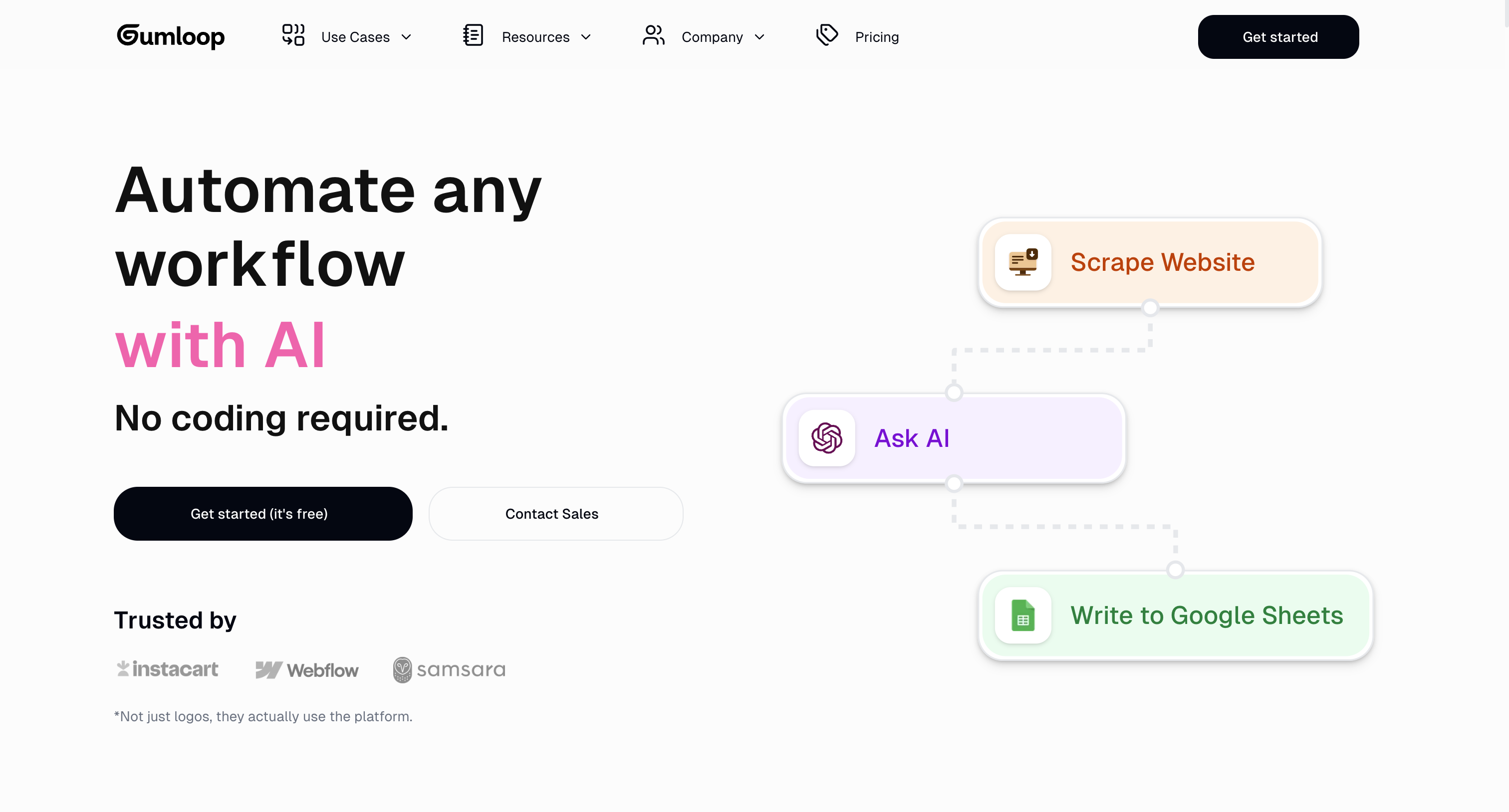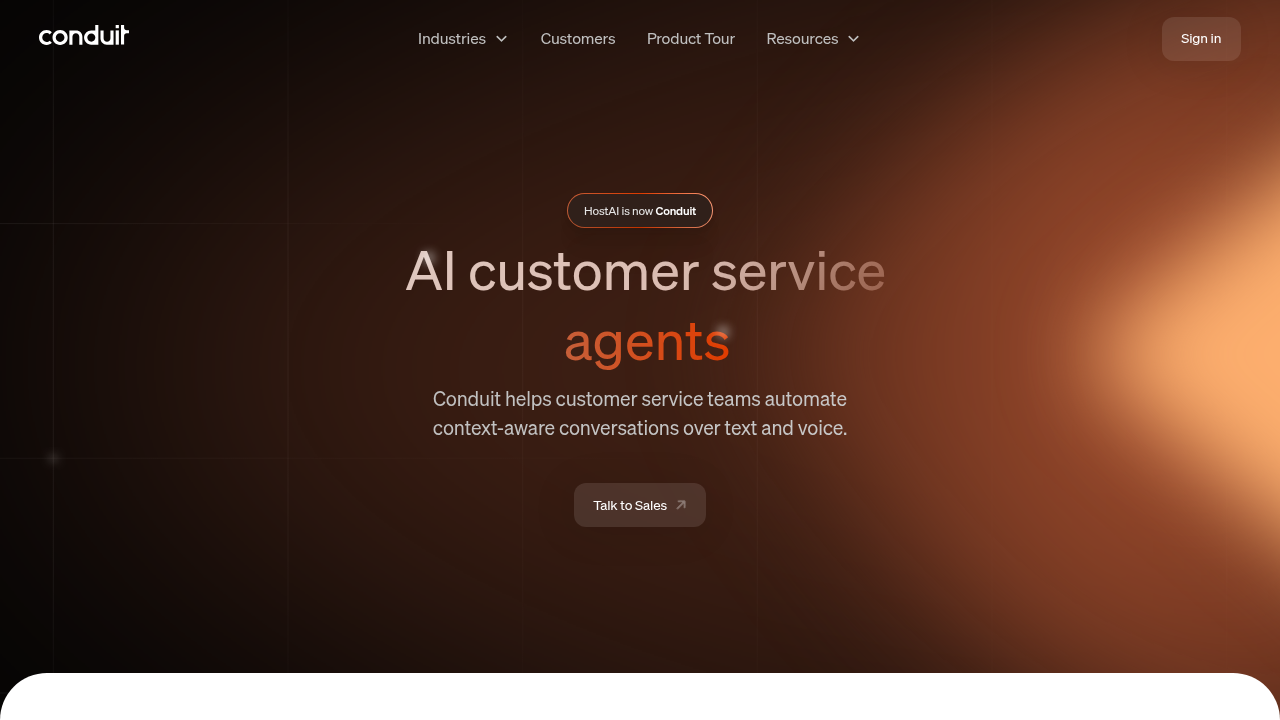Conduit vs Gumloop for Conversational AI in 2025

Both Conduit and Gumloop can handle AI-powered automation, but they take completely different approaches for customer conversations. If you're building workflows that involve talking to customers (whether through voice, chat, or messaging) the platform you choose makes a huge difference in complexity and results. Conversational AI requires specialized features that general automation tools often struggle with. Here's how to match your specific communication needs to the right platform.
TLDR:
- Conduit is a specialized conversational AI platform for customer communications, while Gumloop is a general no-code automation tool that can add conversational elements through integrations
- Conduit provides native voice, SMS, chat, and email features with deep CRM integrations, while Gumloop requires manual configuration for conversational AI capabilities
- Gumloop offers more workflow flexibility but uses expensive credit-based pricing (20+ credits per advanced AI call) and has a steep $97/month starting price
- Conduit has a shorter learning curve for customer communications and is optimized for high-volume conversations without per-action costs
- The choice depends on whether you need specialized conversational AI features or general automation with occasional conversational elements

How Each Platform Works
Conduit is a conversational AI platform designed for sales and support workflows. The platform integrates AI chatbots and other omnichannel conversational AI tools to automate time-consuming processes and effectively serve your target audience, combining voice AI, messaging, and workflow automation into a unified system. Conduit connects directly with CRMs, property management systems, and other business tools to provide context-aware conversations that can handle complex customer interactions across SMS, WhatsApp, email, voice calls, and chat.
Gumloop takes a different approach as a no-code platform for automating workflows with AI. Rather than focusing on conversational AI alone, Gumloop provides a visual workflow builder where users drag and drop modular components to create AI-powered automations. Builders drag, drop, and connect modular components onto a canvas to build powerful automations, providing the tools and infrastructure to operate faster than writing, testing, and productionizing code.
The platform can add conversational elements through integrations with OpenAI and other AI models, but these are components within broader automation workflows rather than the core focus. This fundamental difference shapes how each platform approaches customer communication challenges.
The real value in 2025 is no longer in basic voice AI infrastructure: it's in pairing conversational AI with your business context and all the complicated integrations you need to run a modern business.

Direct Feature Comparison
Conversational AI Features
Conduit provides native conversational AI designed for customer-facing communications. The platform includes voice AI for inbound and outbound calls, AI messaging across multiple channels, and a unified inbox that centralizes all customer interactions. The system includes built-in reasoning engines and knowledge bases that allow context-aware responses tailored to business needs.
For businesses in property management, this means AI agents can access reservation details, guest preferences, and property information during conversations. The best conversational AI platforms integrate smoothly with existing business systems rather than requiring complex manual setup.
Gumloop excels at creating automated workflows, especially for basic automations like data harvesting and email sending, but it lacks sophisticated AI decision-making features and does not support voice AI. This means that for more complex tasks requiring advanced interventions like responses to customer queries, Gumloop may not be the ideal choice. While Gumloop can integrate with conversational AI models through its node system, it requires manual configuration and doesn't provide the specialized conversational features that businesses need for customer service and sales.
The difference becomes clear when you need to handle complex customer conversations that require understanding context, managing escalations, and maintaining conversation history across multiple channels.
Workflow Automation Complexity
Gumloop shines in its flexibility for building complex, multi-step automations. They have a concept of "subflows" where you can program a series of actions in the middle of your workflow that come together to form a bigger whole. They also have something called "Interfaces" where you can give external third parties the ability to enter data that kicks off an automation. The platform supports conditional logic, loops, and can handle workflows with hundreds of steps.

However, this flexibility comes with major limitations. While running each flow only costs 1 credit, executing more advanced tasks will consume a considerable amount. For instance, each time you use an advanced AI call and take advantage of tools like ChatGPT-4o or Claude 3.5 Sonnet, you'll be charged 20 credits. And each time you organize data taken from a website, you'll be charged between 30 and 60 credits: integrations can cost up to 20 credits each. This means executing just one multi-step workflow could cost over 100 credits.
Conduit takes a different approach by providing pre-built, optimized workflows designed for conversational AI use cases. While less flexible than Gumloop's general-purpose builder, Conduit's workflows are purpose-built for sales and support scenarios, including automated task creation, intelligent routing, and escalation management.
Integration and Data Management
Both platforms offer extensive integration options, but with different focuses. Gumloop integrates with popular CRM platforms like Salesforce and HubSpot and supports dozens of other business tools. However, these integrations are primarily for data transfer and basic automation rather than creating sophisticated conversational experiences.
Conduit provides deeper integrations designed for conversational AI workflows. The platform natively connects with CRMs and property management systems to synchronize customer data and context, allowing AI agents to access real-time information during conversations. This creates more intelligent interactions where the AI can reference customer history, account details, and business context without requiring separate data enrichment steps.
For example, when a guest calls about their reservation, Conduit's AI can immediately access their booking details, previous conversations, and property information. With Gumloop, you'd need to build these data connections manually and manage the complexity of keeping conversational context synchronized across multiple workflow steps.

The top property management tools understand that integration depth matters more than integration breadth for customer communications.
Performance and Scalability Limitations
Right now, Gumloop can be a bit slow for super long and complex workflows, but for simpler flows it's extremely fast. The platform's credit-based pricing model can become expensive for businesses running frequent, complex automations. Credits are consumed by actions in your workflows: more complex or AI-heavy tasks use more credits. If you go over your monthly limit, you can buy extra credits at a per-credit fee.
The Starter Plan is pricey for small users at $97/month, which is a big jump, especially if you're a freelancer or need basic automation. There's no lower-cost paid tier, which is a common complaint. Pro and Enterprise tiers are designed for teams running large-scale automations, but for most solo users, the price can be hard to support.
Conduit focuses on conversational AI scalability with optimized infrastructure for handling high-volume customer interactions. The platform is designed to support businesses that need to process thousands of conversations simultaneously without the complexity of managing individual workflow credits.
This approach makes more sense for businesses where conversational AI is a core function rather than an occasional automation task.
Conduit as the Better Choice for Conversational AI
While Gumloop offers impressive general-purpose automation features, Conduit stands out as the better choice for businesses focused on conversational AI applications. Companies are deploying chatbots and virtual assistants to achieve greater scalability in support and other functions while meeting customer demand for faster service delivery. At the same time, consumers and business users are growing more appreciative of the opportunities unlocked by conversational AI technology.

Conduit tackles the core challenge that many businesses face when trying to implement conversational AI with general automation tools. Rather than building complex workflows from scratch like in Gumloop, Conduit provides purpose-built conversational AI features that work out of the box. This includes intelligent routing, context-aware responses, escalation management, and unified communication management: all important for modern customer service and sales operations.
The platform's competitive advantage lies in combining conversational AI with strong workflow automation designed for customer-facing interactions. Unlike Gumloop, which requires businesses to piece together conversational elements manually, Conduit provides a complete solution that integrates voice, messaging, and workflow automation in a single platform optimized for sales and support teams.
For businesses in hospitality, property management, or professional services, this difference is important. You need AI that understands your industry's communication patterns, not a general automation tool that treats conversations like any other data processing task.
Frequently Asked Questions
Which platform is better for small businesses?
Conduit typically offers better value for small businesses focused on customer communications. While Gumloop's $97/month starting price can be steep for basic needs, Conduit's conversational AI features provide immediate value without requiring extensive technical setup or ongoing workflow management.
Can Gumloop handle voice calls like Conduit?
Gumloop can integrate with voice AI services through its node system, but it requires manual configuration and doesn't provide native voice features. Conduit includes built-in voice AI designed for customer conversations, making it much easier to implement and manage phone-based customer interactions.
How do the learning curves compare?
Conduit has a shorter learning curve for conversational AI use cases because it's purpose-built for customer communications. Gumloop offers more flexibility but requires understanding workflow logic, node connections, and integration management. Most businesses can get started with Conduit's conversational features in hours rather than weeks.
Which platform scales better for high-volume conversations?
Conduit is optimized for high-volume conversational AI with infrastructure designed to handle thousands of simultaneous customer interactions. Gumloop's credit-based system can become expensive for frequent, complex conversational workflows, making it less suitable for businesses with high conversation volumes.
Decision Guidance for Your Business
The choice between Conduit and Gumloop depends on your primary business objectives and technical requirements. For businesses that need general-purpose automation with occasional conversational elements, Gumloop's flexibility may support its complexity and cost structure. However, for organizations focused on customer communications, sales, and support, Conduit provides a more targeted and cost-effective solution.
Consider Conduit when your business requires native conversational AI features, integrated voice and messaging systems, and purpose-built workflows for customer interactions. The platform's focus on conversational AI means faster implementation, lower learning curves, and better results for customer-facing applications.
Choose Gumloop only if you need extensive general automation features beyond conversational AI and have the technical expertise to build complex workflows from scratch, and no voice AI support. However, be prepared for higher costs and complexity when implementing conversational features.
The best Zapier alternatives for conversational AI recognize that specialized tools often outperform general-purpose platforms for specific use cases.
Conclusion
You can change your customer communications by combining conversational AI with the workflow automation your business actually needs. While voice AI infrastructure has become commoditized, the real value lies in connecting that technology to your business context and integrations: something general workflow builders simply can't deliver effectively.
Conduit's conversational AI changes how sales and support teams operate. Instead of juggling multiple tools and duct-taped solutions, you get voice, SMS, email, and chat unified with your CRM, knowledge base, and business workflows in one platform. Your AI agents don't just respond. They access real customer data, create tasks, identify upsell opportunities, and escalate complex issues smoothly.
That's just the start of what you can accomplish. You can automate entire customer journeys from first contact to resolution, deploy AI that actually understands your business context, and give your team a unified inbox that centralizes everything. For businesses serious about scaling their customer communications, Conduit offers the focused features and native integrations needed to succeed without the complexity of building these features from scratch.
_.png)


.svg)
